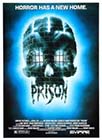
Main cast: Viggo Mortensen (Burke), Chelsea Field (Katherine Walker), Arlen Dean Snyder (Captain Carl Horton), Lincoln Kilpatrick (Cresus), Tom Everett (Rabbitt), Ivan Kane (Joe “Lasagna” Lazano), André DeShields (Sandor), Tommy Lister (Tiny), Stephen Little (Rhino Reynolds), Mickey Yablans (Brian Young), Larry “Flash” Jenkins (Hershey), and Lane Smith (Warden Eaton Sharpe)
Director: Renny Harlin


I catch Prison on late night TV and am entranced for one reason alone: Viggo Mortensen when he was younger was hot. He’s still hot now, mind you, but back then, he was another kind of hot, the hotness that mothers warn their daughters about. Well, that is, until he opens his mouth, and the voice that comes out never matches the appearance. God is fair, people.
The movie is a mess, though. Basically, it’s about this haunted prison run by the tyrannical Warden Eaton Sharpe, whose old-school iron-fist ways has observer Katherine Walker aghast. However, the State Board doesn’t take her warnings seriously. The drama begins when this prison is reopened again for business, and reunites Sharpe with prisoner Cresus. Both men share a history: they implicated Charlie Forsythe years ago, which sent Forsythe to the electric chair. The arrival of a prisoner, the car thief Burke, who is a dead ringer for Forsythe triggers the ghost to begin a murderous spree using CGI that is quite dated by today’s standards. So the fun begins.
I won’t call this movie horror, specifically – it’s more of an action-driven prison movie with occasional death scenes that are more CGI-heavy than scary. It’s hard to be scared when the special effects scream 1980s, complete with flashy laser beams now and then and the obligatory “laser beam going pew-pew-pew” accompanying sounds. More bewilderingly, the ghost could have gone straight to Sharpe directly, but instead, he takes his time to kill various prisoners – most of them people of color, leaving the white characters to survive in the end, because the 1980s were a different time back then – and these prisoners have nothing to do with his execution at all. So what is the point? Target practice? The ghost ends up killing only one person responsible for his death, while the other victims are bystanders. In a way, the ghost is living up the murderous reputation he was framed for. Hmm, maybe that is the point?
Many characters in this movie exist solely to die – take a few of them away, and all that will be missing in this movie are their death scenes. Indeed, some characters are built up to be something more, even relegating Burke to the sidelines at times, only to die meaninglessly anyway, eventually. Katherine is a waste of space – she can be completely erased from this movie and nothing will be different. No, seriously, she accomplishes nothing here, does nothing of significance, and in the pivotal scene, she is still useless. Is she in this movie because someone is obligated to give Chelsea Field a role? It’s not like this movie is rife with man-man tension and they need a female character to distract people who gets squeamish about such a thing.
Even Burke is quite the waste of a character, as he is a classic Marty Sue type. He displays no vulnerabilities or weaknesses – he can do anything here, and his expression is set to smug from beginning to end. This is a lead character that exists solely to move the plot, and it’s hard to care for this fellow when it’s clear that the whole thing is a cake walk for him.
The only thing noteworthy is the few scenes in which Mr Mortensen appears only in tighty-whities, but come on now. He shows far more, even his dangling banjos, in other movies, so watching Prison for the meaty Mortensen is like trying to play table tennis with a baseball bat – one is better off watching those other movies for that kind of stuff.
All in all, this movie is an incoherent mess, worth a look only if folks were looking to see the late Lane Smith play the human equivalent of Daffy Duck.
